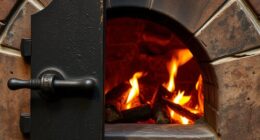To control sparks when burning wood, start by choosing high-quality, well-seasoned hardwoods like oak or maple, and verify the wood is dry with a moisture content below 20%. Use proper ignition techniques, such as lighting small, dry sticks first, and avoid overloading your stove. Keep your firebox clean and ensure good airflow by maintaining vents and dampers. If you’re interested, you’ll find more detailed tips to enhance your fire safety.
Key Takeaways
- Use hardwoods like oak, hickory, or maple for cleaner burning and fewer sparks.
- Ensure wood is properly seasoned (below 20% moisture) for safer ignition and reduced sparks.
- Start fires with matches or long lighters, adding small, dry sticks before larger logs.
- Regularly clean and maintain the firebox and vents to promote proper airflow and contain sparks.
- Avoid overloading the stove or fireplace to prevent excess sparks and ensure safe operation.
Essential Tips for Safe Spark Control

Are you unsure how to guarantee your wood stove or fireplace sparks safely and efficiently? Ensuring proper spark control starts with understanding ignition safety and the quality of the wood you use. When you’re dealing with open flames or burning appliances, sparks are inevitable, but controlling them minimizes fire hazards and keeps your home safe. The first step is to prioritize ignition safety by choosing the right wood, which directly impacts how sparks behave and how safely they burn. High-quality wood burns cleaner and produces fewer unpredictable sparks compared to poorly seasoned or low-grade wood. Always opt for hardwoods like oak, hickory, or maple, which have low moisture content and produce a steady, controlled flame. Avoid softwoods like pine or cedar, as they tend to be more resinous and generate more sparks, making ignition safety trickier to manage.
Properly seasoned wood is essential for achieving ideal ignition safety. Wood that’s dried for at least six to twelve months reduces excess moisture, which can cause uneven burning and unpredictable sparks. When you check your wood’s moisture level—ideally below 20%—you’re helping ensure sparks stay manageable and your stove operates efficiently. Using wet or green wood not only produces more sparks but also leads to creosote buildup, increasing fire risk. Make sure your wood is split into appropriate sizes for your stove or fireplace, which promotes thorough drying and even burning. Well-seasoned wood ignites faster, produces less smoke, and results in fewer dangerous sparks flying out of control. Additionally, maintaining proper fireplace maintenance and regular cleaning helps prevent blockages that could cause sparks to escape unintentionally.
Another key aspect of spark control involves your fire-starting technique. Always use safe ignition methods, like matches or long lighters, and avoid overloading your stove or fireplace. Overfilling can cause excess sparks and increase the chance of sparks escaping the firebox. When lighting your fire, start from the bottom with crumpled newspaper or firelighters, and gradually add small, dry sticks before progressing to larger logs. This controlled approach minimizes sudden sparks and helps you maintain ignition safety throughout the process. Regularly inspect your stove’s air vents and damper settings as well, because proper airflow promotes complete combustion and reduces the likelihood of sparks escaping.
Frequently Asked Questions
What Are the Best Spark Control Products Available Today?
You should consider products like spark arrestor screens, spark guards, and automatic spark control devices to guarantee safety. Regular spark control maintenance is essential for preventing fires, so check and clean your equipment frequently. Always follow safety precautions, such as wearing protective gear and keeping fire extinguishers nearby. These measures help you manage sparks effectively, keeping your wood stove or fireplace safe and efficient.
How Often Should I Inspect My Spark Control System?
You should inspect your spark control system at least once a season or after heavy use. During inspections, focus on spark plug maintenance and check for signs of wear or damage. Regularly troubleshoot your ignition system to guarantee reliable sparks. If you notice misfires or difficulty starting, perform ignition system troubleshooting promptly. Routine checks help prevent issues, keep your system running smoothly, and ensure safe, efficient operation.
Can I Install Spark Control Devices Myself?
Yes, you can do a DIY installation of spark control devices, but you must follow safety precautions closely. Make sure to read the manufacturer’s instructions thoroughly and wear protective gear. Turn off power and disconnect any electrical sources before starting. If you’re unsure or uncomfortable with electrical work, it’s best to consult a professional. Prioritizing safety guarantees proper installation and prevents accidents or damage.
What Are Common Signs of Spark Control Failure?
If your ignition system isn’t functioning properly, you might notice frequent sparks or difficulty igniting your fire, indicating a spark control failure. You could also see signs like inconsistent flames, smoke, or poor combustion efficiency. These issues suggest the spark control device isn’t regulating the sparks correctly, which hampers ignition and affects combustion efficiency. Addressing these signs promptly helps maintain safe, efficient operation of your wood stove or fireplace.
Are There Eco-Friendly Options for Spark Control?
Yes, there are eco-friendly options for spark control that promote sustainable solutions. You can opt for spark guards made from recycled or biodegradable materials, which reduce environmental impact. Additionally, choosing advanced ignition systems with lower energy consumption helps minimize emissions. Using these sustainable solutions not only enhances safety but also supports eco-conscious practices, ensuring your wood-burning setup remains environmentally friendly while maintaining effective spark control.
Conclusion
Remember, controlling sparks is like taming fire itself—an act of respect and vigilance. Keep your checklist close, stay alert, and handle your wood with care, for even the smallest spark can ignite a blaze. Like a steady hand guiding a lantern through darkness, your attention guarantees safety and warmth. Stay mindful, stay prepared, and let your spark control be the steady rhythm that keeps your home safe and bright.









